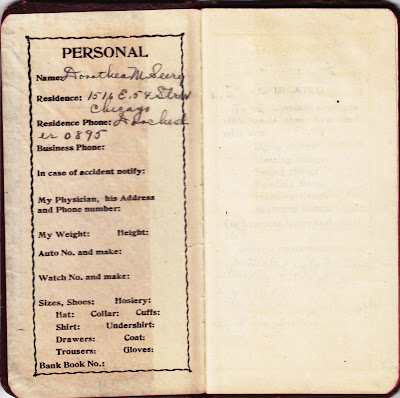Throughout my life, I have found librarians to be incredibly resourceful, enthusiastic, and encouraging people. My experiences during this research project have been no exception! If you are doing a historical research project like this, I highly recommend taking a trip to your local library to glean some helpful tips and information from these knowledge experts.
Recently, Dana & I walked into the Harold Washington Library and approached the Visual & Performing Arts Department's reference desk with high hopes. I told the Chicago/Vaudeville/ancestral story to a friendly librarian who showed me a few research tips, leading us to many Chicago Tribune articles about our ancestors (I will post them in an upcoming post!). The Chicago Public Library has digital access to the full Chicago Tribune archive. She told us in closing that I should also talk to Bob Sloane, their Art Unit Head and dance expert.
I later emailed Bob Sloane with my story, and he came back with an incredible find. Turns out, the Chicago Public Library archived all of the old music union cards, including those from the 1920's. I went back to the library to check out what he found. We talked for nearly an hour, while he taught me how to do various searches & explored various research avenues. I left the library with clear instructions to look up the "Dick Lucke" archive files from the popular vaudeville (and still running strong!) newspaper, Variety , which I soon did. I found about 95 articles! The articles are loaded with the names of venues & other acts that shared the stage with the Luckes! Only the date and an abstract of the article is visible online without a subscription to Variety. The next step is to go back with all of the dates that I found and go through the microfiche Variety collection housed at the Harold Washington Library. The articles can then be copied and used for further research.
I also left with two tangible treasures, unearthed by librarian Bob Sloane:
I also left with two tangible treasures, unearthed by librarian Bob Sloane:
Here we have a union card from my great grandpa, R.R. (Dick) Lucke, member of the Chicago Federation of Musicians.
Instruments listed: Piano & drums.
Years active: 1924-1930, 1935
Phone number: 0895, the same as the Seery household number from Dottie's 1922 diary. You'll see a lot of cancellations & renewals on Dick's card: librarian Bob Sloane told me that the union clerks were very efficient- the moment your card expired, it was stamped so.
 He lists his address as 5119 Dorchester, which I was able to find on Google- http://www.emailflyers.net/email-flyer-2704.htm. Check out the link for interior shots & real estate listing information.
He lists his address as 5119 Dorchester, which I was able to find on Google- http://www.emailflyers.net/email-flyer-2704.htm. Check out the link for interior shots & real estate listing information.The house is a beautiful Hyde Park greystone, built 1n 1888 in the Victorian style. The going price today is $795,000.
I've never seen this address before on other documents. My guess is it belonged to a friend or was a boarding house that Dick & Dottie used for lodging while travelling the vaudeville circuit. They stayed here and used Dottie's parents' home phone as a contact number, nearby at 1516 E 54th Street. Check out this map of Hyde Park, a close up view of the neighborhood they sometimes called home, after a day/evening of performing together: Dottie dancing with her troupe Marie Veatch and her Chicago Steppers or Chicago Debutantes & Dick playing piano or drums along side his brother Walt with the band, Dick Lucke and His Arcadians.

Here we have Walt Lucke's union card.
Member of the Chicago Federation of Musicians. Instrument listed: Sax.
Years active: 1931
This must be a second card, as Walt was certainly an active musician in the 1920's.
He lists his address as the Bradley Hotel, Chicago, located on the northwest corner of N. Rush Street and E. Grand Avenue. Check out this map of the downtown area where Walt would rest after a day/evening of playing his saxophone and other reed instruments on stage. The hotel was just one block west of the Mag Mile, right in the heart of all the action.




































.JPG)




.JPG)
.JPG)




